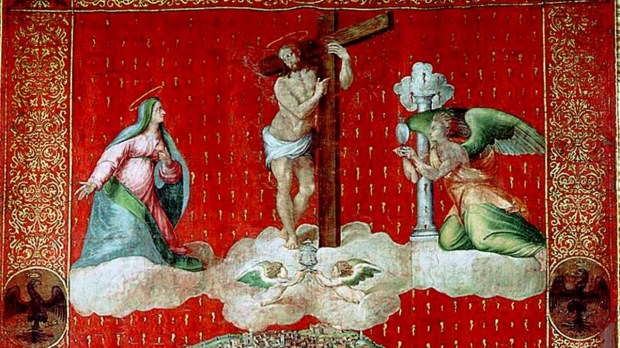Lenten Campaign 2025
This content is free of charge, as are all our articles.
Support us with a donation that is tax-deductible and enable us to continue to reach millions of readers.
During the Middle Ages and the Reinassace, each town in Italy had its own “gonfalone,” an intricately designed banner representing the city’s core symbols. These banners were not just political symbols, but outright works of art, often completed by the best artists of the time.
In the case of L’Aquila, a medieval town at the foothills of the Grand Sasso mountain, capital of the central Italian region of Abruzzo, the town’s banner was completed by a local master of Mannerist art, Giovanni Paolo Cardone.

The monumental banner, measuring 130 square feet, represents four patron saints who offer the city of L’Aquila to Christ through the intercession of the Virgin Mary. At the center of the painting we find a detailed rendering of L’Aquila, which is an unusual artistic choice for the time — most Renaissance artists created idealized versions of a city rather than its actual outline.
Cardone presents the city as supported by four saints: St. Maximus, St. Peter Celestinus, St. Bernardino of Siena, and St. Equitius. In the upper part of the banner we find Christ, the Virgin Mary and an angel in front of a column, probably a symbol of the Church, while in the lower part we see St. Anthony of Padua, St. Francis of Assisi, St. John of Capistrano, and two local bishops.

Cardone created this majestic representation of the city’s patron saints by painting his subjects on red silk, following a technique that got popular in the Renaissance after many Italian cities became silk producers. It was completed in 1576 and placed inside the basilica of St. Bernardino, where it was preserved until 1865. The banner was later transferred to the civic art museum and finally to the National Museum of Abruzzo.
In 2009, when a brutal 5.8 magnitude earthquake destroyed much of L’Aquila, killing 309 people, the gonfalone was one of the many artworks that were damaged. After being extracted out of the partly crumbled National Museum of Abruzzo, it was transferred to Florence’s Opificio delle Pietre Dure, a national center specializing in restoration and cultural preservation.
In January 2025, the 500-year-old banner was finally returned to its location in the National Museum of Abruzzo after extensive restoration works led by Opificio’s Emanuela Daffra.
The restoration, sponsored by Italy’s Banking Association, was challenging due to the monumental dimensions of the silk banner, the wear of its materials, and the damage caused by the earthquake, restorers said in a press release. To bring the banner back to its former glory, the team resorted to experts from both textile and painting teams.
“It is a work that plays an important role in the city’s identity,” restorers said in a statement. “Returning this banner to the National Museum of Abruzzo therefore takes on a strong symbolic connotation.”



